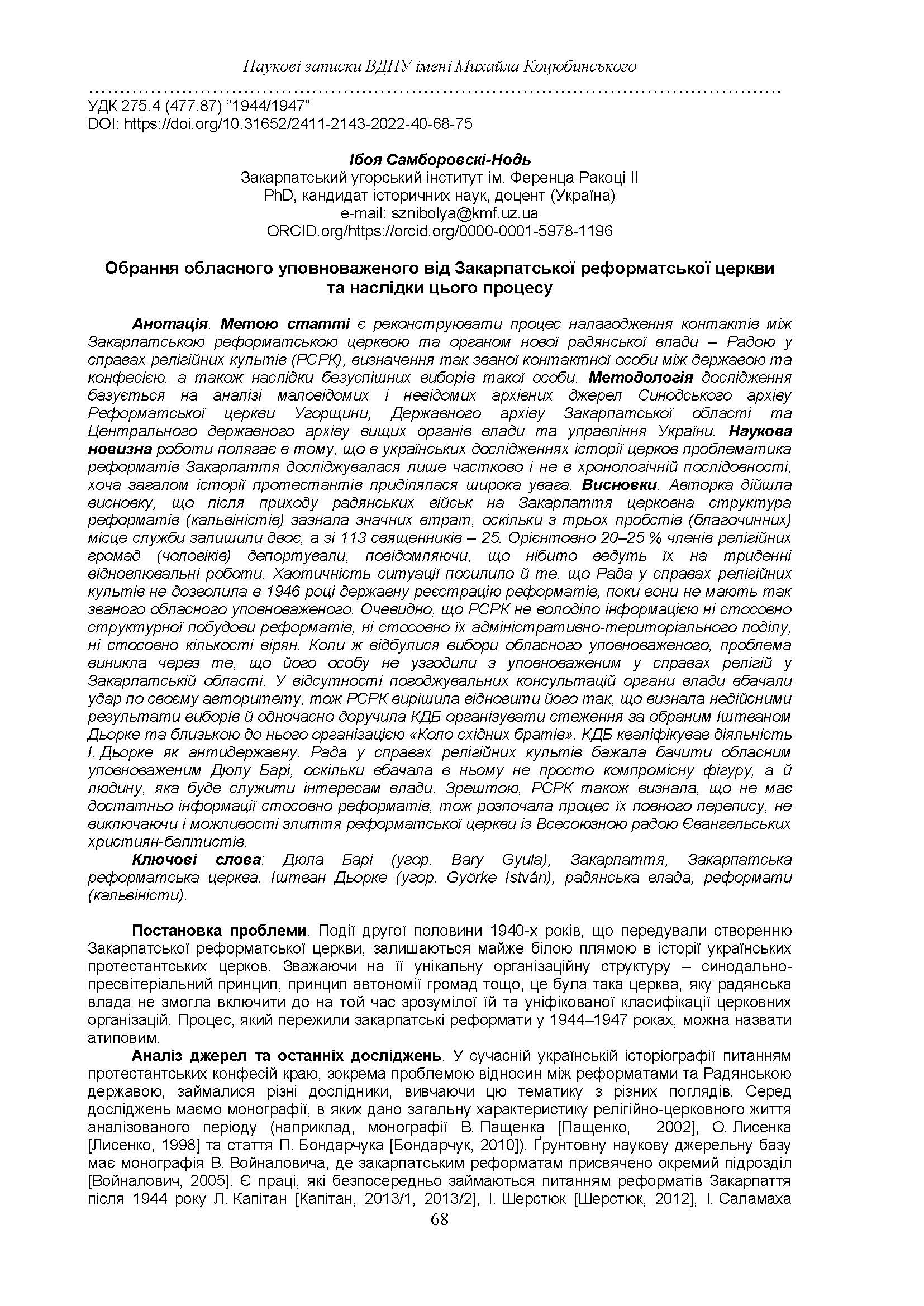Abstract
The aim of the article is to reconstruct the establishment of contacts between the Reformed Church of Transcarpathia and the Council for the Affairs of Religious Cults, the new regional office in the area, as well as the appointment of the so-called contact person between the state and the denomination, and the consequences of a failed election. Methodology the study is based on the analysis of little-known and unknown archival sources including the Synod Archives of the Reformed Church in Hungary, the Transcarpathian Regional State Archives and the Central State Archives of Supreme Bodies of Power and Government of Ukraine. The novelty of the study lies in the fact that in Ukrainian church history research, the problem of the Transcarpathian Calvinists has been only partially and not chronologically researched. However, the history of Protestants received widespread attention. Conclusions. The author came to the conclusion that following the Soviet invasion of Transcarpathia, the Reformed (Calvinist) church organization suffered significant damage since two of its three deans and 25 of its 113 pastors had left the office. In addition, 20–25% of congregation (male) members were carried off for what was called a three days’ restoration work but in fact were deported. The chaotic situation was exacerbated by the fact that the state registration of the Reformed Church was rejected by the Council for the Affairs of Religious Cults office in 1946, until the time a territorial representative was appointed. Meanwhile, it also turned out that the religious office was unaware of either the organizational structure or the territorial distribution of the Reformed Church, or even the number of believers belonging to the denomination. However, when the territorial representative was elected, the fact that his appointment had not been agreed on with the regional religious commissioner caused another problem.
The authorities considered the failure of agreement an insult and as a result, the Council for the Affairs of Religious Cults office asserted its authority by invalidating the results of the election. Moreover, it initiated a State Security Committee (KGB) surveillance of the elected Györke's friends. Similarly, the KGB classified Györke's activities as anti-state. The Council for the Affairs of Religious Cults wanted to see Bishop Bary as the territorial representative because it was believed that his willingness to compromise would serve the interests of state power. The Council for the Affairs of Religious Cults had also become aware of its lack of knowledge about the Reformed Church and therefore, it launched a full screening of the church. Furthermore, the Council did not rule out the possibility of its incorporation into the organization of the Evangelical Christian Baptists.
References
Fodor, Gusztáv. (2016). A Kárpátaljai Református Egyház élete a sztálini egyházpolitika szorításában [Життя реформатської церкви на Закарпатті в віджимі сталінської церковної політики.] In Molnár D. Erzsébet – Molnár D. István (Eds.). A kommunizmus áldozatai, rehabilitációs alternatívák Kelet-Közép Európában. Nemzetközi tudományos konferencia anyagai, 170–198. Beregszász–Ungvár: „Rik-U” Kiadó.
Horkay, Barnabás. (1998). A Keleti Baráti Kör. Képek a kárpátaljai ébredésből. H.n. [Коло східних братів. Картини закарпатського відродження].
KRELM – Kárpátaljai Református Egyház Levéltára és Múzeuma [Архів і музей Закарпатської реформатської церкви, Берегове].
Bary/1 Gyula beregi ref. esperes levele Nagytiszteletű Györke István úrnak egyházmegyei főjegyző, tanácsbíró Beregújfalu [Лист бережського реф. пробста Дюли Барі до вельмишановного пана Іштвана Дьорке, головного писаря єпархії, радника Берегуйфалу]. Оригінал листа надав автору Сабольч Дьорке, син Іштвана Дьорке.
Bary/2 Gyula beregi ref. esperes levele a Területi Vallásügyi Meghatalmazottnak Ungvárra. 1.K.i./1947. sz. alatt. [Лист бережського реф. пробста Дюли Барі до уповноважений РСРК у Закарпатській області № 1.K.i./1947]. Оригінал листа надав автору Сабольч Дьорке, син Іштвана Дьорке (за що автор хоче йому ще раз подякувати).
MRE ZSL – Magyar Református Egyház Zsinati Levéltára [Синодський архів Реформатської церкви Угорщини, Будапешт].
Szamborovszkyné Nagy, Ibolya. (2020). „Egyedül, de hitünkben megerősödve”. Bary Gyula lelkészi tevékenysége az első Csehszlovák Köztársaság idején. [«Один, але зміцнений у своїй вірі». Душпастирська діяльність Дюли Барі за часів першої Чехословацької республіки]. Teológiai Fórum, 2, 147–176. Режим доступу: http://www.refteologia.sk/TF_2020_2.pdf
АУСБУЗО – Архів Управління Служби Безпеки України в Закарпатській області.
Бондарчук П. (2010). Особливості релігійної ситуації в Україні у середині 1940-х – на початку 1950-х рр. Український історичний журнал, 2, 137–163.
Войналович В. (2005). Партійно-державна політика щодо релігії та релігійних інституцій в Україні 1940–1960-х років: політологічний дискурс: [монографія]; НАН України, Ін-т політ. і етнонац. дослідж. Київ: Світогляд. 741 с.
ДАЗО – Державний архів Закарпатської області.
Капітан, Л. (2013/1). Процес реєстрації реформатських громад в повоєнному Закарпатті: прояв лояльності чи політична гра. Краєзнавство, 2, 139–145.
Капітан, Л. (2013/2). Реформатська церква Закарпаття у контексті антирелігійної політики радянської адміністрації повоєнних років. Гуржіївські історичні читання, 6, 240–443
Лешко О. (2002). Державна політика і протестантські громади Закарпаття в 1946–1949 роках. Carpatika–Карпатика. Вип. 20. Релігія та церква в центральної та південно-східної Єиропи. Ужгород. 105–114.
Лешко О. (2003). Реформатське духовенство Закарпаття в другій половині 40–50-х роках. Наук. вісн. Ужгород. нац. ун-ту. Серія: Історія, 9, 74–82.
Лисенко О. (1998). Церковне життя в Україні. 1943–1946 рр. Київ: Інститут історії України НАНУ, 403 с.
Пащенко В. (2002). Греко-католики в Україні (від 40-х років ХХ ст. до наших днів. Полтава: АСМІ, 616 с.
РГАСПИ – Российский государственный архив социально-политической истории.
Саламаха І. (2001). Реформатська церква Закарпаття в перші післявоєнні роки (1945–1948). Історія релігій в Україні. Праці ХІ Міжнародної наукової конференції. (Кн.1.) Львів, 372–378.
ЦДАВОВУ – Центральний державний архів вищих органів влади та управління України.
Шерстюк I. (2012). Закарпатська реформатська церква у перші повоєнні роки. Історична пам'ять, 28, 85–92.

This work is licensed under a Creative Commons Attribution 4.0 International License.
Copyright (c) 2022 Ібоя Самборовскі-Нодь





